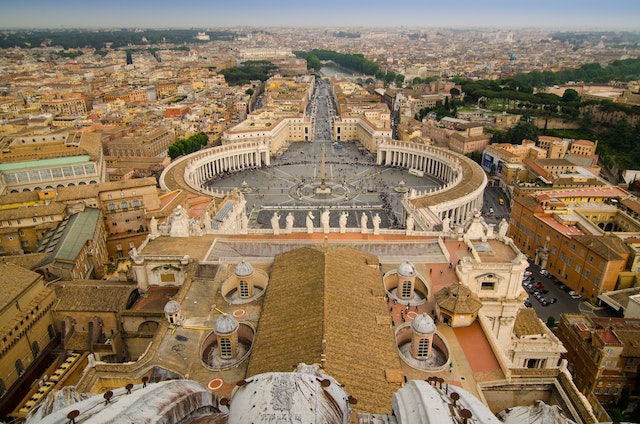
How did the Vatican become a country? Benito Mussolini gave it to the Roman Catholic church in 1929.
The Vatican is the world’s smallest country. It has a population of 453 people and is 0.44 square kilometers. That makes it about 2,500 times smaller than the city of Rome, which surrounds it. The Vatican is governed by the Holy See, which means the Pope and the Catholic Church.
The Vatican City is named for the Ager Vaticanus, which was a marshy area, on the other side of the Tiber River from Rome. The area frequently flooded and was all but uninhabited. In AD 33, Agrippina the Elder had the area drained and laid out beautiful gardens. The area became more popular, and a lot of powerful people started to build their villas there. Emperor Caligula started to build a circus for chariot races in his garden but he died before it was finished. Nero completed the work, and it became known as the Circus of Nero. In AD 64, there was a huge fire that destroyed most of Rome. Nero blamed the Christians, and many early Christians were martyred in the area, and it is said to be where St. Peter was executed. St. Peter was famously executed upside down because he said that he wasn’t worthy of being executed in the same way as Jesus.
Emperor Constantine reversed Roman policy in the 4th century by embracing Christianity. He ordered a basilica to be built over the tomb of St. Peter, which was not the St. Peter’s Basilica that stands there today. That was built in the 16th century, when the old basilica became too structurally unsound to be used. In 846, Saracen pirates attacked and damaged the basilica. Pope Leo IV ordered a wall around the area to be constructed for protection. That wall pretty much marked out the area that is the Vatican today.
The first pope is technically St. Peter. All subsequent popes are all his successors. The early popes had a pretty hard life, and many of them were martyred. It was only after the reign of Emperor Constantine that life because easier for them and they began to accumulate wealth and power. The emperor gave Pope Miliades a palace, called the Lateran Palace, which became the home of the bishop of Rome. This palace is about 2 km away from the site of the Vatican. Popes continued to live in the Lateran Palace, but in the 5th century, Pope Symmachus built a second palace to be an alternative residence for the pope. This palace was much closer to St. Peter’s Basilica and is located inside the Vatican boundary.
From 1257 onwards, Rome became unstable, and the pope started to live in different cities across Italy. They were known as the Bishop of Rome, but they didn’t live there. In the 14th century, things became even more unsafe, and the popes moved to France. They were controlled by the King of France, but they had his protection. It wasn’t until 1420 that the popes were able to return to Rome, and they have been there ever since. The popes became increasingly more powerful and they began to govern parts of Rome as an independent state, known as the Papal State. They were called upon to arbitrate between other nations and their power grew. They took over larger areas of Rome.
Things continued smoothly for the popes until all of the states within Italy were unified by King Victor Emmanuel II, in 1870. The King and the Italian government didn’t interfere with church matters, but they did start to take away parts of the territory that the Holy See controlled. The popes retreated behind the walls that surrounded the Vatican area and they refused to recognize the authority of the new Italian king. Subsequent popes refused to leave the walls of the Vatican until the situation was resolved and the pope who was the last real ruler of the papal states was known as “the prisoner of the Vatican”.
This situation dragged on until 1929, when Mussolini, the head of King Emmanuel III’s government signed a treaty with Pope Pius XI at the Palace of Lateran. This treaty recognized the area of the Vatican as an independent state that would be controlled by the Holy See. Italy also paid the Holy See back for all of the territory it had taken. And that is how the Vatican became a country. And that is what I learned today.
Sources
https://en.wikipedia.org/wiki/Old_St._Peter%27s_Basilica
https://en.wikipedia.org/wiki/Lateran_Treaty
https://en.wikipedia.org/wiki/Lateran_Palace
https://en.wikipedia.org/wiki/History_of_the_papacy
https://www.thevaticantickets.com/vatican-history/
https://en.wikipedia.org/wiki/Vatican_City
https://www.history.com/topics/religion/vatican-city
https://seanmcdowell.org/blog/was-peter-crucified-upside-down
